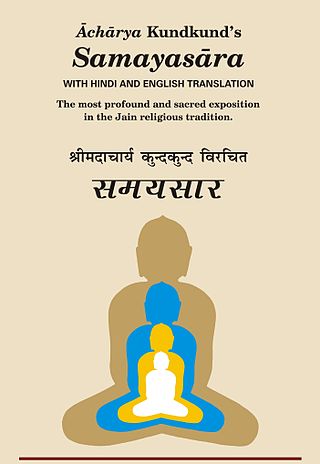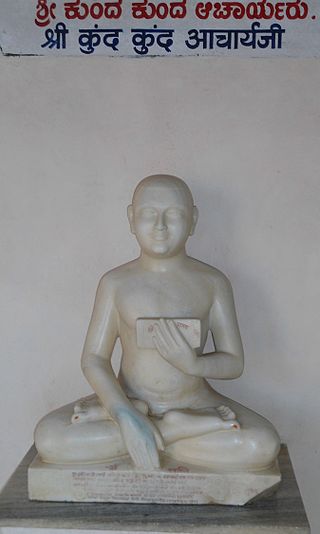
Tapas is a variety of austere spiritual meditation practices in Indian religions. In Jainism, it means asceticism ; in Buddhism, it denotes spiritual practices including meditation and self-discipline; and in the different traditions within Hinduism it means a spectrum of practices ranging from asceticism, inner cleansing to self-discipline by meditation practices. The Tapas practice often involves solitude and is a part of monastic practices that are believed to be a means to moksha.

Tattvārthasūtra, meaning "On the Nature [artha] of Reality [tattva]" is an ancient Jain text written by Acharya Umaswami in Sanskrit, sometime between the 2nd- and 5th-century CE.
In Jainism, Kashaya are aspects of a person that can be gained during their worldly life. According to the Jaina religion as long as a person has Kashayas, they will not escape the cycle of life and death. There are four different kind of Kashayas, each being able to gain their own kinds of intensity.

Karma is the basic principle within an overarching psycho-cosmology in Jainism. Human moral actions form the basis of the transmigration of the soul. The soul is constrained to a cycle of rebirth, trapped within the temporal world, until it finally achieves liberation. Liberation is achieved by following a path of purification.
Kaivalya is the ultimate goal of aṣṭāṅga yoga and means "solitude", "detachment" or "isolation", a vrddhi-derivation from kevala "alone, isolated". It is the isolation of purusha from prakṛti, and liberation from rebirth, i.e., Moksha. Kaivalya-Mukti is described in some Upanishads, such as Muktika and Kaivalya as the most superior form of Moksha which can grant liberation both within this life, as Jivanmukti, and after death, as Videhamukti.

Samayasāra is a famous Jain text composed by Acharya Kundakunda in 439 verses. Its ten chapters discuss the nature of Jīva, its attachment to Karma and Moksha (liberation). Samayasāra expounds the Jain concepts like Karma, Asrava, Bandha (Bondage), Samvara (stoppage), Nirjara (shedding) and Moksha.
Jain philosophy or Jaina philosophy refers to the ancient Indian philosophical system of the Jain religion. It comprises all the philosophical investigations and systems of inquiry that developed among the early branches of Jainism in ancient India following the parinirvāṇa of Mahāvīra. One of the main features of Jain philosophy is its dualistic metaphysics, which holds that there are two distinct categories of existence: the living, conscious, or sentient beings (jīva) and the non-living or material entities (ajīva).
Jain texts assign a wide range of meaning to the Sanskrit dharma or Prakrit dhamma. It is often translated as “religion” and as such, Jainism is called Jain Dharma by its adherents.

Sanskrit moksha or Prakrit mokkha refers to the liberation or salvation of a soul from saṃsāra, the cycle of birth and death. It is a blissful state of existence of a soul, attained after the destruction of all karmic bonds. A liberated soul is said to have attained its true and pristine nature of infinite bliss, infinite knowledge and infinite perception. Such a soul is called siddha and is revered in Jainism.
Jainism emphasises that ratnatraya — the right faith, right knowledge and right conduct — constitutes the path to liberation. These are known as the triple gems of Jainism and hence also known as Ratnatraya

Jain philosophy explains that seven tattva constitute reality. These are:—
- jīva- the soul which is characterized by consciousness
- ajīva- the non-soul
- āsrava (influx)- inflow of auspicious and evil karmic matter into the soul.
- bandha (bondage)- mutual intermingling of the soul and karmas.
- samvara (stoppage)- obstruction of the inflow of karmic matter into the soul.
- nirjara - separation or falling-off of part of karmic matter from the soul.
- mokṣha (liberation)- complete annihilation of all karmic matter.
The karmic process in Jainism is based on seven truths or fundamental principles (tattva) of Jainism which explain the human predicament. Out of those, four—influx (āsrava), bondage (bandha), stoppage (saṃvara) and release (nirjarā)—pertain to the karmic process. Karma gets bound to the soul on account of two processes:
Asrava is one of the tattva or the fundamental reality of the world as per the Jain philosophy. It refers to the influence of body and mind causing the soul to generate karma.
Samvara (saṃvara) is one of the tattva or the fundamental reality of the world as per the Jain philosophy. It means stoppage—the stoppage of the influx of the material karmas into the soul consciousness. The karmic process in Jainism is based on seven truths or fundamental principles (tattva) of Jainism which explain the human predicament. Out of the seven, the four influxes (āsrava), bondage (bandha), stoppage (saṃvara) and release (nirjarā)—pertain to the karmic process.

Dravyasaṃgraha is a 10th-century Jain text in Jain Sauraseni Prakrit by Acharya Nemicandra belonging to the Digambara Jain tradition. It is a composition of 58 gathas (verses) giving an exposition of the six dravyas (substances) that characterize the Jain view of the world: sentient (jīva), non-sentient (pudgala), principle of motion (dharma), principle of rest (adharma), space (ākāśa) and time (kāla). It is one of the most important Jain works and has gained widespread popularity. Dravyasaṃgraha has played an important role in Jain education and is often memorized because of its comprehensiveness as well as brevity.

Umaswati, also spelled as Umasvati and known as Umaswami, was an Indian scholar, possibly between 2nd-century and 5th-century CE, known for his foundational writings on Jainism. He authored the Jain text Tattvartha Sutra. Umaswati's work was the first Sanskrit language text on Jain philosophy, and is the earliest extant comprehensive Jain philosophy text accepted as authoritative by all four Jain traditions. His text has the same importance in Jainism as Vedanta Sutras and Yogasutras have in Hinduism.

Digambara Sādhu is a Sādhu in the Digambar tradition of Jainism, and as such an occupant of the highest limb of the four-fold sangha. They are also called Nirgranth which means "one without any bonds". Digambar Sādhus have 28 primary attributes which includes observance of the five supreme vows of ahimsa (non-injury), truth, non-thieving, celibacy and non-possession. A Digambar Sādhu is allowed to keep only a feather whisk, a water gourd and scripture with him.

Āchārya means the Head of an order of ascetics. Some of the famous achāryas are Bhadrabahu, Kundakunda, Samantabhadra, Umaswami, Sthulibhadra.
In Jain tradition, twelve contemplations, are the twelve mental reflections that a Jain ascetic and a practitioner should repeatedly engage in. These twelve contemplations are also known as Barah anuprekśa or Barah bhāvana. According to Jain Philosophy, these twelve contemplations pertain to eternal truths like nature of universe, human existence, and karma on which one must meditate. Twelve contemplations is an important topic that has been developed at all epochs of Jain literature. They are regarded as summarising fundamental teachings of the doctrine. Stoppage of new Karma is called Samvara. Constant engagement on these twelve contemplations help the soul in samvara or stoppage of karmas.









